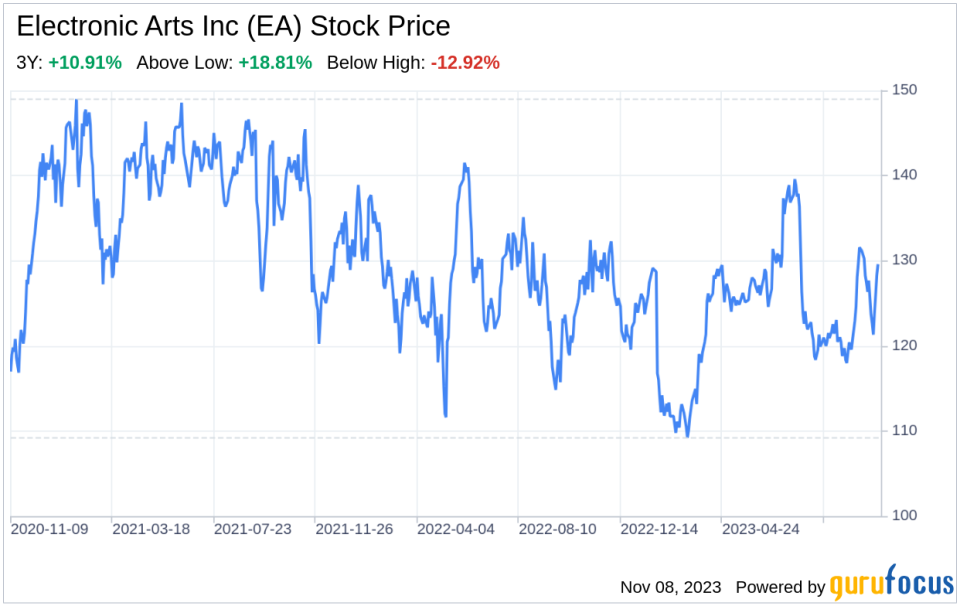The Electronic Arts Inc (EA) Company: A Short SWOT Analysis
```html
Electronic Arts Inc (NASDAQ:EA) showcases robust financial performance with increased net income and comprehensive income.
EA's transition to EA SPORTS FC and focus on live services signal strategic growth opportunities.
Intense competition and industry consolidation pose significant threats to EA's market position.
EA's digital delivery and free-to-play models present both opportunities and challenges in a rapidly evolving gaming landscape.
Electronic Arts Inc (NASDAQ:EA), one of the world's leading video game publishers, filed its 10-Q on November 7, 2023, revealing a nuanced financial landscape. The company reported a slight increase in net revenue to $1,914 million for the three months ended September 30, 2023, up from $1,904 million in the same period the previous year. Net income saw a more substantial rise, from $299 million to $399 million, indicating a stronger profitability. Gross profit also increased to $1,458 million from $1,442 million. However, operating expenses rose by 7 percent, and operating income decreased by 12 percent year-over-year. These figures set the stage for a detailed SWOT analysis, providing investors with a comprehensive view of EA's strategic position and future prospects.

Strengths
Financial Robustness: EA's financial health is a testament to its operational success. The company's net income surged to $399 million, up from $299 million in the previous year, showcasing its ability to generate profit and reinvest in growth. This financial robustness is further evidenced by a comprehensive income of $440 million, marking a significant increase from the $365 million reported in the prior year. EA's strong balance sheet, with total cash, cash equivalents, and short-term investments of $2,305 million, provides the company with the flexibility to navigate market fluctuations and invest in strategic initiatives.
Brand and Franchise Strength: EA's portfolio of iconic franchises, including Madden, EA Sports FC, Battlefield, Apex Legends, Mass Effect, Dragon's Age, and Need for Speed, continues to be a cornerstone of its success. The company's ability to leverage these brands has not only fostered a loyal customer base but also allowed for recurrent revenue streams through live services and extra content. The transition to the EA SPORTS FC brand and the sustained popularity of franchises like Apex Legends demonstrate EA's brand power and its impact on the company's market position.
Weaknesses
Increasing Operating Expenses: Despite EA's strong revenue growth, the company faces challenges with rising operating expenses, which have increased by 7 percent year-over-year. This uptick in costs, particularly in research and development, marketing, and sales, could pressure profit margins if not managed effectively. As the gaming industry evolves, EA must balance the need to invest in innovation and marketing with the imperative to control expenses and maintain profitability.
Dependence on Hit Titles: EA's financial performance is heavily reliant on the success of its key franchises. This dependence poses a risk, as the underperformance of a single major title can have a material adverse impact on the company's financial results. The company's transition to a new EA SPORTS FC brand, while offering growth opportunities, also introduces uncertainty and the need for strategic management to ensure continued success and player engagement.
Opportunities
Expansion of Live Services: EA's live services and other net revenue, although slightly down by 1 percent year-over-year, remain a significant part of the business, with $1,293 million reported for the quarter. The company's focus on live services, including extra content and subscription offerings, presents an opportunity to grow recurring revenue streams and enhance player engagement. As more players engage with EA's games and services, the potential for revenue growth through these channels is substantial.
Digital Delivery and Free-to-Play Models: The industry trend towards digital delivery and free-to-play models offers EA opportunities to reach a broader audience and capitalize on lower distribution costs. EA's digital full game downloads and free-to-play offerings, such as Apex Legends and The Sims 4, align with consumer preferences and have the potential to drive future revenue growth. The company's strategic focus on these models can help it adapt to changing market dynamics and player behaviors.
Threats
Intense Industry Competition: EA operates in a highly competitive industry, with threats from both established companies and emerging start-ups. The intensifying competition, fueled by industry consolidation and the entry of well-funded technology firms into gaming, poses a significant threat to EA's market share and profitability. The company must continuously innovate and differentiate its products to maintain its competitive edge.
Market Volatility and Economic Conditions: External factors such as economic downturns and market volatility can impact consumer spending on entertainment, including video games. EA's performance is subject to these broader market forces, which can affect game sales and player engagement. The company must remain agile and responsive to economic trends to mitigate the potential adverse effects on its business.
In conclusion, Electronic Arts Inc (NASDAQ:EA) exhibits a strong financial foundation and brand equity, with opportunities to expand its live services and capitalize on digital trends. However, the company must navigate rising operating expenses, reliance on hit titles, fierce competition, and economic uncertainties. EA's strategic focus on innovation, digital delivery, and player engagement will be critical in leveraging its strengths and opportunities while addressing its weaknesses and threats in the evolving gaming landscape.
```
This article, generated by GuruFocus, is designed to provide general insights and is not tailored financial advice. Our commentary is rooted in historical data and analyst projections, utilizing an impartial methodology, and is not intended to serve as specific investment guidance. It does not formulate a recommendation to purchase or divest any stock and does not consider individual investment objectives or financial circumstances. Our objective is to deliver long-term, fundamental data-driven analysis. Be aware that our analysis might not incorporate the most recent, price-sensitive company announcements or qualitative information. GuruFocus holds no position in the stocks mentioned herein.
This article first appeared on GuruFocus.
